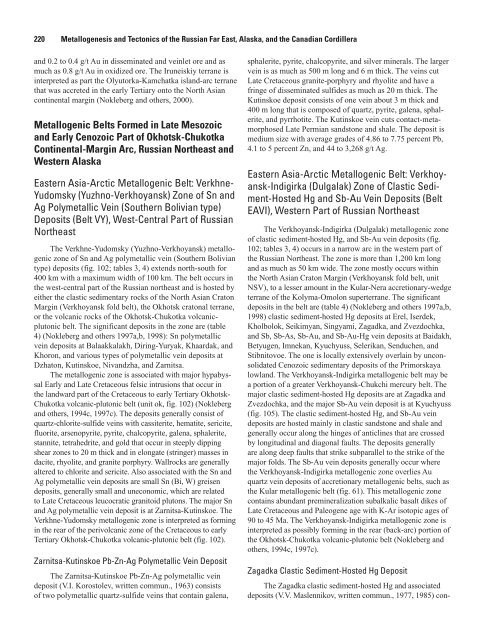USGS Professional Paper 1697 - Alaska Resources Library
USGS Professional Paper 1697 - Alaska Resources Library
USGS Professional Paper 1697 - Alaska Resources Library
Create successful ePaper yourself
Turn your PDF publications into a flip-book with our unique Google optimized e-Paper software.
220 Metallogenesis and Tectonics of the Russian Far East, <strong>Alaska</strong>, and the Canadian Cordillera<br />
and 0.2 to 0.4 g/t Au in disseminated and veinlet ore and as<br />
much as 0.8 g/t Au in oxidized ore. The Iruneiskiy terrane is<br />
interpreted as part the Olyutorka-Kamchatka island-arc terrane<br />
that was accreted in the early Tertiary onto the North Asian<br />
continental margin (Nokleberg and others, 2000).<br />
Metallogenic Belts Formed in Late Mesozoic<br />
and Early Cenozoic Part of Okhotsk-Chukotka<br />
Continental-Margin Arc, Russian Northeast and<br />
Western <strong>Alaska</strong><br />
Eastern Asia-Arctic Metallogenic Belt: Verkhne-<br />
Yudomsky (Yuzhno-Verkhoyansk) Zone of Sn and<br />
Ag Polymetallic Vein (Southern Bolivian type)<br />
Deposits (Belt VY), West-Central Part of Russian<br />
Northeast<br />
The Verkhne-Yudomsky (Yuzhno-Verkhoyansk) metallogenic<br />
zone of Sn and Ag polymetallic vein (Southern Bolivian<br />
type) deposits (fig. 102; tables 3, 4) extends north-south for<br />
400 km with a maximum width of 100 km. The belt occurs in<br />
the west-central part of the Russian northeast and is hosted by<br />
either the clastic sedimentary rocks of the North Asian Craton<br />
Margin (Verkhoyansk fold belt), the Okhotsk cratonal terrane,<br />
or the volcanic rocks of the Okhotsk-Chukotka volcanicplutonic<br />
belt. The significant deposits in the zone are (table<br />
4) (Nokleberg and others 1997a,b, 1998): Sn polymetallic<br />
vein deposits at Balaakkalakh, Diring-Yuryak, Khaardak, and<br />
Khoron, and various types of polymetallic vein deposits at<br />
Dzhaton, Kutinskoe, Nivandzha, and Zarnitsa.<br />
The metallogenic zone is associated with major hypabyssal<br />
Early and Late Cretaceous felsic intrusions that occur in<br />
the landward part of the Cretaceous to early Tertiary Okhotsk-<br />
Chukotka volcanic-plutonic belt (unit ok, fig. 102) (Nokleberg<br />
and others, 1994c, 1997c). The deposits generally consist of<br />
quartz-chlorite-sulfide veins with cassiterite, hematite, sericite,<br />
fluorite, arsenopyrite, pyrite, chalcopyrite, galena, sphalerite,<br />
stannite, tetrahedrite, and gold that occur in steeply dipping<br />
shear zones to 20 m thick and in elongate (stringer) masses in<br />
dacite, rhyolite, and granite porphyry. Wallrocks are generally<br />
altered to chlorite and sericite. Also associated with the Sn and<br />
Ag polymetallic vein deposits are small Sn (Bi, W) greisen<br />
deposits, generally small and uneconomic, which are related<br />
to Late Cretaceous leucocratic granitoid plutons. The major Sn<br />
and Ag polymetallic vein deposit is at Zarnitsa-Kutinskoe. The<br />
Verkhne-Yudomsky metallogenic zone is interpreted as forming<br />
in the rear of the perivolcanic zone of the Cretaceous to early<br />
Tertiary Okhotsk-Chukotka volcanic-plutonic belt (fig. 102).<br />
Zarnitsa-Kutinskoe Pb-Zn-Ag Polymetallic Vein Deposit<br />
The Zarnitsa-Kutinskoe Pb-Zn-Ag polymetallic vein<br />
deposit (V.I. Korostolev, written commun., 1963) consists<br />
of two polymetallic quartz-sulfide veins that contain galena,<br />
sphalerite, pyrite, chalcopyrite, and silver minerals. The larger<br />
vein is as much as 500 m long and 6 m thick. The veins cut<br />
Late Cretaceous granite-porphyry and rhyolite and have a<br />
fringe of disseminated sulfides as much as 20 m thick. The<br />
Kutinskoe deposit consists of one vein about 3 m thick and<br />
400 m long that is composed of quartz, pyrite, galena, sphalerite,<br />
and pyrrhotite. The Kutinskoe vein cuts contact-metamorphosed<br />
Late Permian sandstone and shale. The deposit is<br />
medium size with average grades of 4.86 to 7.75 percent Pb,<br />
4.1 to 5 percent Zn, and 44 to 3,268 g/t Ag.<br />
Eastern Asia-Arctic Metallogenic Belt: Verkhoyansk-Indigirka<br />
(Dulgalak) Zone of Clastic Sediment-Hosted<br />
Hg and Sb-Au Vein Deposits (Belt<br />
EAVI), Western Part of Russian Northeast<br />
The Verkhoyansk-Indigirka (Dulgalak) metallogenic zone<br />
of clastic sediment-hosted Hg, and Sb-Au vein deposits (fig.<br />
102; tables 3, 4) occurs in a narrow arc in the western part of<br />
the Russian Northeast. The zone is more than 1,200 km long<br />
and as much as 50 km wide. The zone mostly occurs within<br />
the North Asian Craton Margin (Verkhoyansk fold belt, unit<br />
NSV), to a lesser amount in the Kular-Nera accretionary-wedge<br />
terrane of the Kolyma-Omolon superterrane. The significant<br />
deposits in the belt are (table 4) (Nokleberg and others 1997a,b,<br />
1998) clastic sediment-hosted Hg deposits at Erel, Iserdek,<br />
Kholbolok, Seikimyan, Singyami, Zagadka, and Zvezdochka,<br />
and Sb, Sb-As, Sb-Au, and Sb-Au-Hg vein deposits at Baidakh,<br />
Betyugen, Imnekan, Kyuchyuss, Selerikan, Senduchen, and<br />
Stibnitovoe. The one is locally extensively overlain by unconsolidated<br />
Cenozoic sedimentary deposits of the Primorskaya<br />
lowland. The Verkhoyansk-Indigirka metallogenic belt may be<br />
a portion of a greater Verkhoyansk-Chukchi mercury belt. The<br />
major clastic sediment-hosted Hg deposits are at Zagadka and<br />
Zvezdochka, and the major Sb-Au vein deposit is at Kyuchyuss<br />
(fig. 105). The clastic sediment-hosted Hg, and Sb-Au vein<br />
deposits are hosted mainly in clastic sandstone and shale and<br />
generally occur along the hinges of anticlines that are crossed<br />
by longitudinal and diagonal faults. The deposits generally<br />
are along deep faults that strike subparallel to the strike of the<br />
major folds. The Sb-Au vein deposits generally occur where<br />
the Verkhoyansk-Indigirka metallogenic zone overlies Au<br />
quartz vein deposits of accretionary metallogenic belts, such as<br />
the Kular metallogenic belt (fig. 61). This metallogenic zone<br />
contains abundant premineralization subalkalic basalt dikes of<br />
Late Cretaceous and Paleogene age with K-Ar isotopic ages of<br />
90 to 45 Ma. The Verkhoyansk-Indigirka metallogenic zone is<br />
interpreted as possibly forming in the rear (back-arc) portion of<br />
the Okhotsk-Chukotka volcanic-plutonic belt (Nokleberg and<br />
others, 1994c, 1997c).<br />
Zagadka Clastic Sediment-Hosted Hg Deposit<br />
The Zagadka clastic sediment-hosted Hg and associated<br />
deposits (V.V. Maslennikov, written commun., 1977, 1985) con-
















